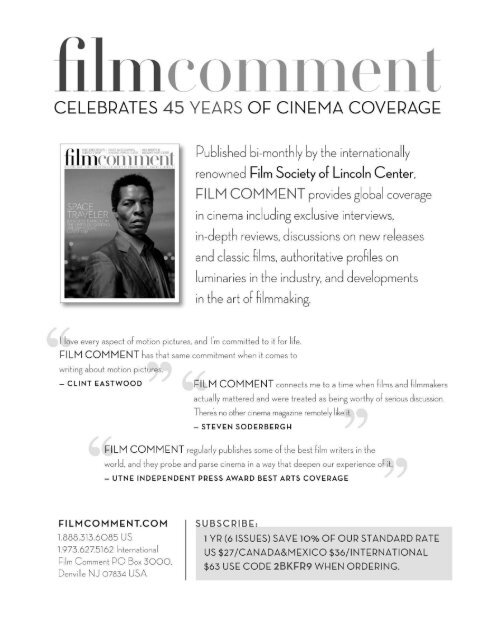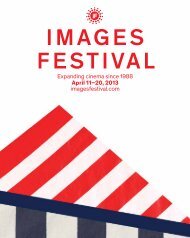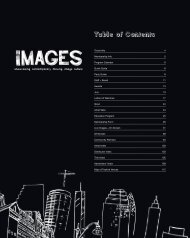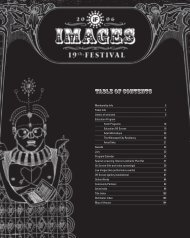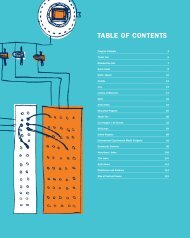TABLE OF COnTEnTS - Images Festival
TABLE OF COnTEnTS - Images Festival
TABLE OF COnTEnTS - Images Festival
You also want an ePaper? Increase the reach of your titles
YUMPU automatically turns print PDFs into web optimized ePapers that Google loves.
Canadian Artist Spotlight: Ross McLaren<br />
Friday April 2<br />
9 PM<br />
Workman Arts, St. Anne’s Parish Hall (651 Dufferin Street at Dundas)<br />
Admission: $10 general/$8 students, seniors, members<br />
On SCREEn<br />
I knew Ross as a filmmaker, collaborator and the founder of<br />
the Funnel, the most important locale for experimental film in<br />
Canada. It wasn’t just the man’s charm, but his films — awkward,<br />
jarring, disjunctive, and, of course, ironic — which grabbed my<br />
attention. It was the late 1970s. It was punk. No one followed,<br />
everyone did what they weren’t expected to do. No reverence for<br />
commercial film, no desire for distribution. You made films because<br />
they needed to be made. Why not try it this way; let’s see what it<br />
looks like. A failure in film was a celebrated success.<br />
And there was Ross, a Sudbury boy in Toronto, recently graduated<br />
from the Ontario College of Art. McLaren began his career cofounding<br />
the Toronto Super 8 Film <strong>Festival</strong>, the first in Canada.<br />
His film Weather Building (1976) is emblematic of this period.<br />
Super 8, edited in camera, science fiction meets visual abstraction.<br />
It is a dissolving, collapsing, repeating visual. It is the antithesis<br />
of Warhol’s ponderous Empire State and a sly homage to Michael<br />
Snow’s incessant panning camera. With its off-screen sounds,<br />
footsteps, wind blowing, there is an uncomfortable energy in<br />
Weather Building, and simultaneously something very cerebral in<br />
its abstracted imagery. The film is an enunciation of the time.<br />
It is 1976. McLaren is actively organizing screenings of films in<br />
the basement of the Centre for Experimental Arts and Communication<br />
(CEAC), a non-institutional, revolutionary art space operating at<br />
the edge of the edge. CEAC’s mastermind and director, Amerigo<br />
Marras, gay, young, was an architecturally trained anti-advocate<br />
for the status quo. He had grown up in radical Italian politics so,<br />
in the fresh cultural territory of Toronto art production, he was<br />
willing to open his cultural space to whatever was tough, Marxist,<br />
advocated world change, and had no time for history and its lies.<br />
Here, one was confronted. Here, in the art basement, McLaren<br />
created his seminal Crash ’N’ Burn (1977), named after the<br />
short-lived downstairs punk club. With a wind-up 16mm Bolex, he<br />
films in silence a visual rendering of the rancorous. Jerky, rough,<br />
in grainy black-and-white, lead singer after lead singer takes off<br />
his shirt, gyrates, shakes his ass in the face of an audience who<br />
scream and jump up and down, up and down, their bodies, the<br />
camera. In the film, the audio is not synced to the visual, but this<br />
is seamless disjunction. The once-stars of early punk, the Dead<br />
Weather Building<br />
1976, 16mm, 10.5 min<br />
Summer Camp<br />
1978, 16mm, 60 min<br />
Wednesday, January 17, 1979<br />
1979, 16mm, 4.5 min<br />
9 X 12<br />
1979-81, 16mm, 1 min<br />
Sex Without Glasses<br />
1983, 16mm, 12.5 min<br />
Dance of the Sacred Foundation<br />
Application<br />
2003, video, 15 min<br />
Boys, Teenage Head, and the Diodes pass as McLaren zooms<br />
in and pans. It is a documentary, yet not. Scratches on the film<br />
reverberate with the snarling performers who want nothing more<br />
than to announce destruction, feign their own deaths, and draw<br />
knives across naked emaciated stomachs. The celluloid explodes<br />
in raucous frenzy: discordant, awkward, and pertinent. These are<br />
not folk singers, these are suffering punks who scream out to us:<br />
“I’m in a coma/Pull the plug on me/ I’m in a coma/please listen<br />
to me/I’ve got the right to live, I’ve got the right to die.” Isn’t this<br />
what it’s about? Kill me, it’s so fuckin’ boring.<br />
While downstairs at CEAC the punks had screamed, five floors<br />
above Amerigo and crew organized an event for every day of the<br />
week and published Strike magazine. When Strike printed a grainy<br />
black-and-white-and-red cover photograph of Aldo Moro’s bloody<br />
body in May 1978, what occurred was a political firestorm in<br />
Conservative Ontario. Within days, all funding was withdrawn and<br />
the RCMP were at the doors. It was over in an instant. The art<br />
community went into a coma of fear; with hardly a word of protest<br />
in defense, CEAC collapsed. McLaren propels out of CEAC’s<br />
womb, tears off, landing at a small warehouse at the eastern end<br />
of Toronto where he finds a new home for the Funnel, an artistcontrolled<br />
location for the making and the showing of film.<br />
<strong>Images</strong><br />
37


